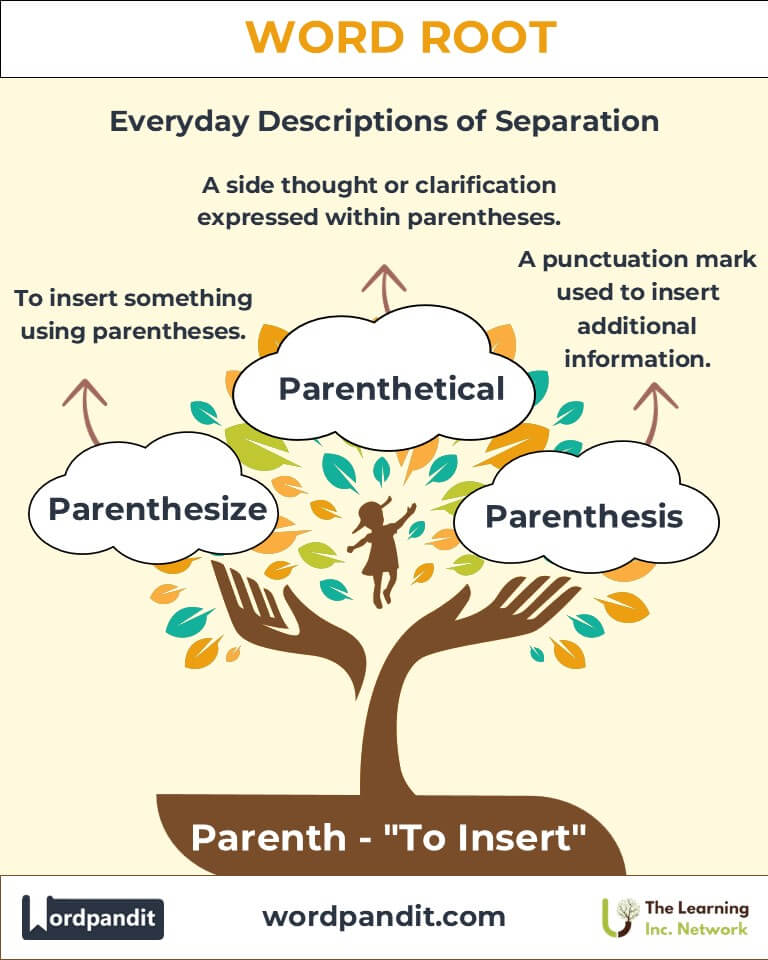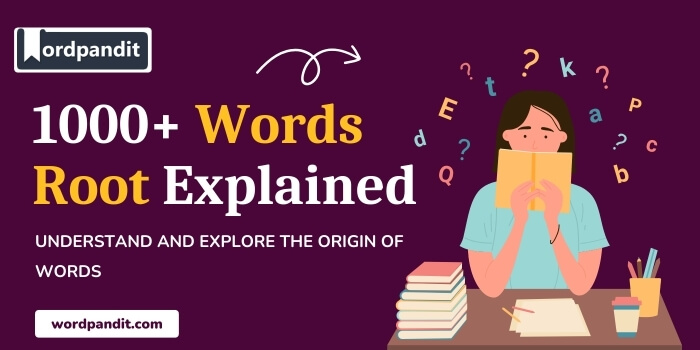Parenth: The Art of Insertion in Language and Thought
Discover the versatility of the root "parenth," derived from the Greek word "parenthesis," meaning "to insert." From its use in grammar to its metaphorical role in thought and conversation, "parenth" weaves the art of interruption and addition into language.

Table of Contents
- Introduction: The Essence of Parenth
- Etymology and Historical Journey
- Mnemonic: Unlocking the Power of Parenth
- Common Parenth-Related Terms
- Parenth Through Time
- Parenth in Specialized Fields
- Illustrative Story: Parenth in Action
- Cultural Significance of the Parenth Root
- The Parenth Family Tree
- FAQs about the Parenth Root
- Test Your Knowledge: Parenth Mastery Quiz
- Conclusion: The Living Legacy of Parenth
Introduction: The Essence of Parenth
Parenth, pronounced "pa-ren-th," is a root that encapsulates the act of insertion. Derived from the Greek word "parenthesis," meaning "putting in beside," it finds its most visible expression in punctuation and grammar. Think of parentheses—those curved brackets ( ) that add additional, often clarifying, information. But parenth doesn’t just live on the page. It also thrives in thought, enabling us to interject ideas or clarify points. In conversation and writing, it embodies the beauty of thoughtful interruptions.

Etymology and Historical Journey
The word root "parenth" originates from the Greek words para (beside) and en-thesis (insertion). In ancient Greece, it described rhetorical and grammatical structures where additional information was placed into a sentence for clarity or emphasis. Over time, the concept migrated into Latin as "parenthesis," becoming a grammatical staple in English during the Renaissance. Parenth has since expanded beyond its literal grammatical meaning, symbolizing interruptions and asides in broader contexts, including philosophy and literature.
Mnemonic: Unlocking the Power of Parenth
Picture an open door leading into a cozy room filled with explanations and clarifications. Parenth is that door, letting in extra meaning.
Mnemonic Device: "Parenth is like parentheses, opening doors for ideas to step in."
Common Parenth-Related Terms
- Parenthesis (pa-ren-thuh-sis):
Definition: A punctuation mark used to insert additional information.
Example: "Her trip to Paris (her lifelong dream) was finally happening." - Parenthetical (pa-ren-theh-ti-kul):
Definition: Relating to or expressed in parentheses; a side thought.
Example: "The parenthetical remark added humor to the otherwise serious text." - Parenthesize (pa-ren-thuh-size):
Definition: To insert something in parentheses.
Example: "You can parenthesize the definition for clarity."
Parenth Through Time
- Parenthesis in Ancient Greece: Used in rhetorical speeches to interject clarifications or persuasive asides.
- Parenthesis in Literature: During the 17th and 18th centuries, parentheses became a hallmark of authors like Laurence Sterne, who used them for humor and self-reflection.
- Parentheses in the Digital Age: Now widely used in coding and computing to structure logic and functions.
Parenth in Specialized Fields
- Grammar and Writing: Parentheses frame supplementary information, improving readability.
- Rhetoric: Parathesis juxtaposes ideas to emphasize a point.
- Mathematics and Coding: Parentheses group operations or functions, ensuring accuracy in calculations and programming.
- Philosophy: Parenthetical thoughts explore tangential ideas, enriching discussions.
Illustrative Story: Parenth in Action
Samantha was preparing her thesis when she realized her arguments needed more clarity. She began using parenthetical citations to reference her sources, helping her ideas flow seamlessly. Her professor praised her ability to "insert supplementary brilliance," showing how the Parenth root enhanced not just her writing but her thinking process.
Cultural Significance of the Parenth Root
Parenth, as a concept, reflects how humans communicate complexity. Whether in Socratic dialogues or Shakespearean plays, the art of inserting additional information mirrors our thought patterns. Parentheses have even influenced visual arts, with curved forms symbolizing openness and inclusion.

The Parenth Family Tree
- Para (beside):
- Parallel: Alongside or analogous.
- Paradox: A statement that contradicts itself yet holds truth.
- En (in):
- Enter: To go inside.
- Engrave: To carve into something.
- Thesis (placing):
- Hypothesis: An assumption placed for testing.
- Synthesis: Combining ideas into a unified whole.
FAQs About the Parenth Word Root
Q: What does "parenth" mean?
A: Parenth means "to insert" and originates from the Greek word parenthesis, combining para (beside) and en-thesis (insertion). It denotes the act of adding extra information or interjecting ideas within a sentence or context.
Q: What are parentheses used for?
A: Parentheses are punctuation marks used to enclose additional or supplementary information that may not be essential to the main sentence but adds clarification or detail. For example: "Her favorite hobby (painting landscapes) is her true passion."
Q: How is "parenthetical" different from "parentheses"?
A: Parentheses refer to the curved punctuation marks ( ). In contrast, parenthetical describes content, tone, or ideas expressed within parentheses or as an aside. For instance, a parenthetical comment can be inserted without actually using parentheses.
Q: Why are parentheses significant in mathematics and coding?
A: Parentheses are crucial in mathematics for grouping operations and ensuring correct calculation sequences based on the order of operations (e.g., in (3 + 2) × 5, the sum inside parentheses is calculated first). In coding, they structure logical functions, conditions, and arguments, helping programs run efficiently and accurately.
Q: Can parentheses or parenthetical ideas impact storytelling?
A: Yes, in literature, parentheses allow authors to provide humorous asides, background details, or reflective thoughts without disrupting the primary narrative. Writers like Laurence Sterne used them extensively to engage readers with wit and depth.
Test Your Knowledge: Parenth Word Root Quiz
1. What does the root "parenth" signify?
2. What is the primary function of parentheses in writing?
3. In what field is the term "parenthetical citation" commonly used?
4. Why are parentheses important in mathematics?
5. How is the rhetorical device "parathesis" used?

Conclusion: The Living Legacy of Parenth
The root "parenth" exemplifies the power of insertion—adding depth, clarity, and nuance to communication. From its origins in ancient rhetoric to its modern applications in grammar and technology, parenth continues to enrich our language and ideas. Whether in parentheses or parenthetical thoughts, let this root inspire you to embrace the art of thoughtful additions.











